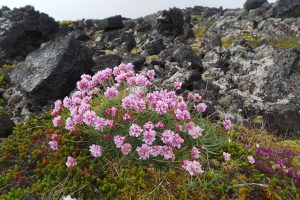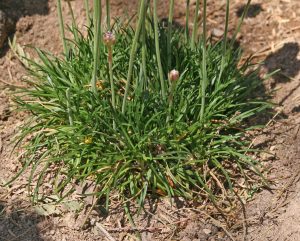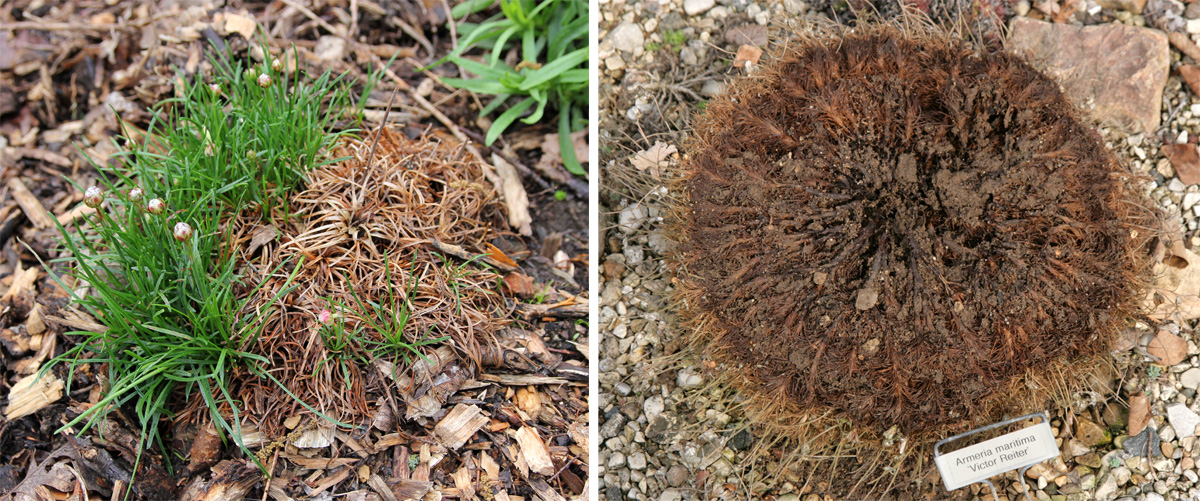
Sea thrift, Armeria maritima, is an herbaceous perennial in the sealavender family (Plumbaginaceae) native to mountains and temperate coastal areas of the northern hemisphere, especially northern Europe, from northern California to Iceland to Siberia. There are several geographic subspecies that vary mainly in flower morphology and pollen structure. It is often found in salty coastal environments where few other plants can grow well. Also called common thrift or sea pink, it is hardy in zones 4 to 8.

This compact evergreen plant grows only 6 to 12 inches high and across from a woody tap root. The slowly expanding mounded tuft is composed of numerous stiff, linear (needle-shaped), dark-green leaves that usually have hairs along their margins. This dense rosette gives the appearance of a low-growing ornamental grass. In richer soils the leaves tend to fall outwards leaving an open center. Since it is evergreen, it should not be cut back to the ground in fall like many other perennials as that will affect spring bloom.
In mid-spring small pink to lavender (or sometimes white) flowers are produced in globular clusters subtended by purplish, papery bracts on the ends of slender, unbranched, leafless stalks that extend well above the foliage. Each flower has five petals joined at the base with five stamens and five separate styles. Deadhead entire flower stems to promote additional sporadic flowering throughout the summer. They can be used as cut flowers. The flowers are followed by papery seed heads with a single seed in each capsule.

Sea thrift grows best in full sun in lean, very well-drained soil. The plants are drought tolerant and do not tolerate moist soils. They frequently rot in the center, killing the entire plant, in heavy clay, soils that are too fertile, or after a prolonged wet and cool fall. Because of this they have a reputation for being short-lived. However, given the proper environment these plants can live for many years and require little maintenance.


Use sea thrift in rock gardens, for edging the front of a perennial border, or massed together in dry, gravelly to sandy beds. Its dense, mounded shape offers good textural contrast with other low-growing plants even when not in bloom (but place it where it will not be overgrown by taller, spreading perennials). It can be used in mixed containers with other small plants. It is excellent in trough gardens which provide the perfect drainage it requires to do well and it is unlikely to be overrun by other larger plants.
Sea thrift is fairly easily propagated from seed, generally flowering in the second year. Sow seeds in spring or fall. It can also be propagated vegetatively by division in spring or basal cuttings taken in summer.
Often plants offered are just the species, but several cultivars are available including:
- ‘Alba’ – is smaller than the species (grows about 5 inches high and wide) with white flowers.
- Armada™ Rose – has bright rose pink flowers on 6-8 inch high plants. There is also a white cultivar in this series.
- ‘Bloodstone’ – has bright deep pink, almost red, flowers.
- ‘Cotton Tail’ – is a short cultivar (6 inches high) with white flowers.
- ‘Dusseldorf Pride’ – has deep pink to wine red flowers on plants 4-5 inches tall and usually repeat flowers in the fall.
- ‘Laucheana’ – has darker green foliage and bright pink flowers that rebloom intermittently.
- ‘Nifty Thrifty’ – this British selection has variegated foliage (a white stripe down the edge of each leaf).
- ‘Rubifolia’ – has magenta-pink flowers and dark burgundy foliage in a mound 4 inches high and 6 inches across. The leaves become greener during the heat of summer.
- ‘Splendens’ – has deep pink flowers.
- ‘Vindictive’ – is a lower-growing form that is recommended as a ground-cover.
– Susan Mahr, University of Wisconsin – Madison





 Asters, Symphyotrichum spp.
Asters, Symphyotrichum spp. Fascinating Fasciation
Fascinating Fasciation Alternatives to Lawn: Groundcovers
Alternatives to Lawn: Groundcovers Marigolds
Marigolds


